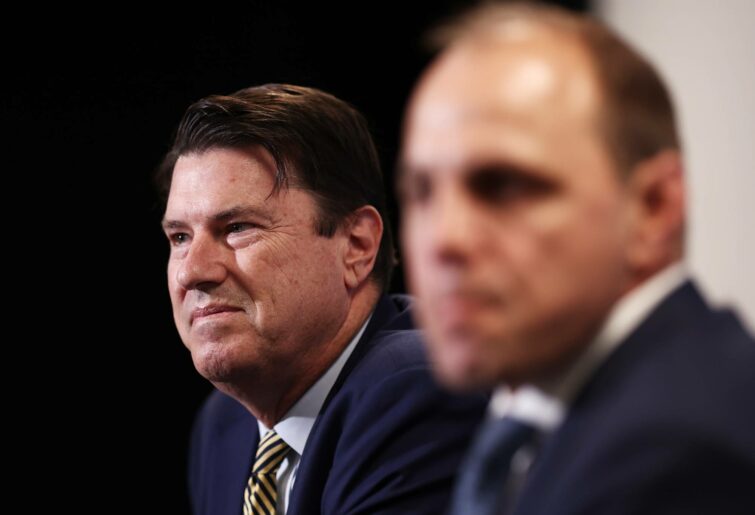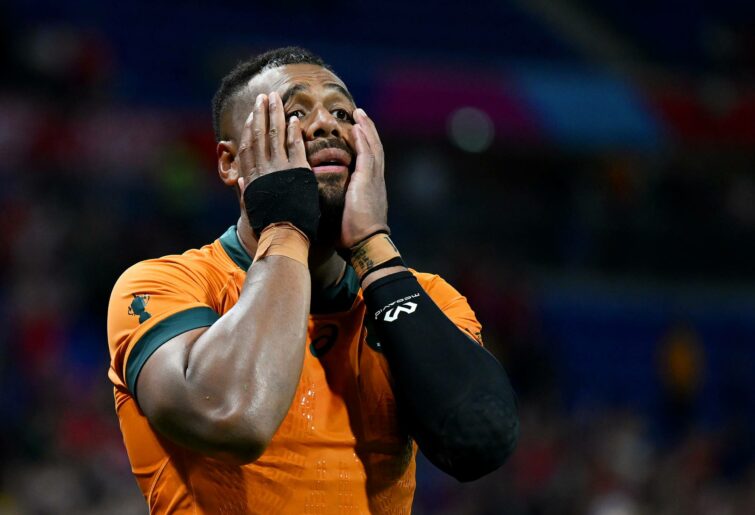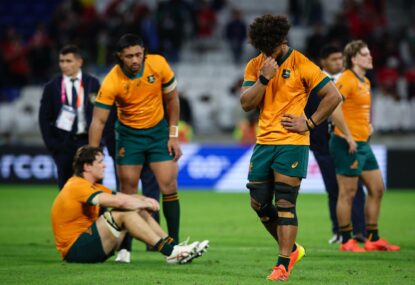All is not lost. The Wallabies have players (when in form) who would be considered for selection in a World XV:
Taniela Tupou, Will Skelton, Rob Valetini, Marika Koroibete, Samu Kerevi and Len Ikitau.
Then we have some others who are not too far away: Angus Bell, Nick Frost and Mark Nawaqanitawase. Then we have some promising youth coming through: Tom Hooper, Carter Gordon, Max Jorgensen and Josh Kemeny.
It is not the players that are the big issue. We can be competitive again. So, what is holding us back? Sure, we have a young team (not enough big game experience), are incohesive (lack of playing time together), lack leadership (too many captains in too short a period), and have coaching issues (baffling selections, unusual assistant coaches, strange game plans, weird usage of the bench, etc.). But these are all just symptoms of a greater malaise. What are the main items that need to change?
Here is the board of directors of Rugby Australia:
– Chairman: Hamish McLennan – Sydney businessman.
– President: Joe Roff – Retired Wallabies player from the ACT Brumbies.
– CEO: Phil Waugh – Retired Wallabies player from the NSW Waratahs.
– Director: Brett Godfrey – Australian businessman (born in Melbourne but has business interests in Tasmania, Victoria, NSW and Queensland – so possibly neutral).
– Director: Daniel Herbert – Retired Wallabies player from Queensland Reds.
– Director: Pip Marlow – Sydney businesswoman.
– Director: Jane Wilson – Brisbane businesswoman.
– Director: Karen Penrose – Brisbane businesswoman.
– Director: Mathew Hanning – Sydney businessman.

Rugby Australia chairman Hamish McLennan. (Photo by Matt King/Getty Images for Rugby Australia)
There are four board members from Sydney, three from Brisbane, one from ACT and possibly one neutral. They are all either elite business people or retired Wallabies. They are all from the top end of town. Interestingly, there aren’t any biographical links to these directors on the RA website. You need to do your own research.
Firstly, is this a true representation of all the rugby stakeholders in Australia? Where are NSW and QLD country represented? Western Australia? South Australia and the Northern Territory? What about schools and club rugby? Which directors look after them? It is not readily apparent, but it should be.
Secondly, most businesses have a long-term strategic plan with the first year usually being the tactical plan. The tactical plan is made up of separate projects which help to achieve the strategic plan. The tactical projects have specific objectives, they have one responsible person for delivering the project and a due date. I cannot find a strategic plan on the RA website. The closest I can find is a media-type release.
This is not a strategic plan. This is just words. RA need to show the document on their website (if it exists). They need to show the projects to achieve the strategic plan, who are the people responsible and the due dates. Here is an example strategic plan from Oceania Rugby.
This plan has plenty of action items, but no responsibilities or due dates, though they may be on another document. It could be largely ineffective without these missing items.
I need to disclose that I perform strategic and tactical plans for businesses. There are common items that all good strategic plans should consider. More importantly, there are hidden or untapped competitive advantages that all businesses also need to consider. These largely come under the heading of having great organisational health. These include (and can all be separate tactical projects):
• Improving the workplace culture (work culture beats strategy so much that the work culture becomes the strategy)
• Employing competent people (get the right people in the right jobs and doing the right things)
• Creating great leaders (lead by example, be humble, consistent, appreciative, criticise indirectly and so on)
• Creating better teamwork (have a sense of purpose, communicate well, champion trust and mutual respect, delegate, be flexible and adaptable)
• Creating a cohesive leadership team (results-oriented, accountable, committed, trusting, respectful, can have healthy conflict) aligned with the strategic plan
• Creating tactical projects to achieve the strategic plan (with persons responsible and due dates)
• Communicating the strategic plan to the wider team (elect a champion for this, usually the creator of the strategic plan)
• Encourage the 4 Cs (critical thinking, creativity and innovation, communication and collaboration) in the workplace
• Enterprise optimisation (pull revenue forward, push expense back, harness the time value of money)
• Integrate all strategic planning (consider all stakeholders, over all time periods, and you need to optimise everything and all at once)
• Measure the success (surveys, deadlines)
I don’t see evidence of any of the above happening at RA. It may be there, but they don’t publicise it. If it is there, then they need to advertise it so that people can scrutinise it and their success.

Samu Kerevi of Australia reacts to Wallabies’ loss. (Photo by Hannah Peters/Getty Images)
It would appear that over the last 20 years or so, RA have pursued a largely top-down approach to their strategic planning. That is, to mainly look after the Wallabies’ elite team, recruit high-profile players from rugby league, attend high-profile events and so on. The idea is to make the Wallabies successful first and then the rest of Australian rugby will follow.
However, a rising tide lifts all boats. From the results over the last 20 years, a steady decline in the Wallabies winning percentages, it would not be too harsh to say that this approach has not worked. It is the right time to rethink that approach and to employ a new approach.
They say a fish rots from the head. This is not true. A fish rots equally all over. They also say that a healthy organisation starts by having a great front office. This I can believe. Losing 40-6 to Wales at the 2023 RWC shows that we don’t have a great front office. We (all rugby stakeholders) need to put one in place… and soon.
We need a board that represents all rugby stakeholders. We need a strategic plan that caters to all levels of rugby in Australia. Not just the top end, the middle or the bottom. We need to optimise all levels all at once.
Another saying is to never waste a good crisis. This is a great opportunity to overhaul everything that is wrong with Australian rugby and to make it great again.
It all starts with getting the right board of directors and a great strategic plan in place.
































































































